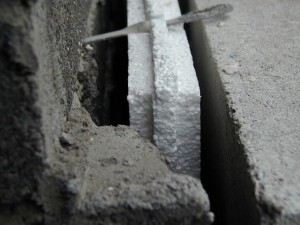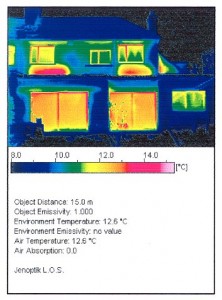Holding firmly onto those thoughts, let us briefly turn our attention to the Construction Sector … and the Energy Performance of Buildings …
A new Home Energy Savings (HES) Scheme was recently announced by Mr. Eamon Ryan T.D., Minister of Communications, Energy & Natural Resources … €100 million Insulation Scheme to Benefit 50,000 Homes – Programme Will Create 4,000 Jobs … according to an article in The Irish Times, on Monday 9th February 2009, by Mr. Harry McGee.
Reading the Department of Energy’s own Press Release for the Scheme Launch, dated 2009-02-08 … it is evident that public relations consultants, marketing gurus, senior academics (who should know better) and civil servants were involved in producing ‘paper’ numbers to justify and support the miserable grants being offered in the HES Scheme. Numbers were even presented for ‘Typical Net BER Improvement’ ?!?
When the Scheme is eventually up and running, Thermal Insulation Contractors will be required to comply with a voluntary Energy Ireland (SEI) ‘Contractors Code of Practice & Standards and Specifications Guidelines’ (version 1, 2009-02-03) … and SEI may or may not carry out control inspections in order to monitor the quality of their work. Does all this sound familiar ?
But … are these paper energy numbers ‘real’ ? If he thinks so, Mr. Eamon Ryan is living in Alice’s Wonderland !
This is a photograph, taken back in 2000, of expanded polystyrene insulation which was badly installed in an external cavity wall … very badly installed ! When the Irish Construction Industry would later enter extreme ‘over-heat’ mode, the quality of typical construction would deteriorate sharply.

Who can know what is happening inside that cavity when it is all finished and covered up from view ? Nobody. Unless, that is, you manage to take an Infra-Red Thermal Image during the next winter heating season – which is far too late to remedy the problem.
This is an example of an Infra-Red Thermal Image, taken back in 1998 …

Explaining the Current Context in Ireland …
It was 10 Years after the Dublin Stardust Fire Tragedy (February 1981) … before the first legal, National Building Regulations were introduced (December 1991); they became operational during the following summer of 1992. Around the same time, Building Control Authorities were being established in every Local Authority.
Prior to this, legal Building Bye-Laws were operated in just a small number of our major urban centres.
Dublin Corporation’s Bye-Laws with respect to the Construction of Buildings, adopted by Dublin City Council on 27th June 1949, were an interesting mix of functional, performance and prescriptive requirements. An Application, containing detailed construction information, for Building Bye-Law Approval had to be made for every construction project … and I mean ‘every’ project … prior to any construction commencing. And, ‘every’ project was inspected at the foundation and drainage stages of construction … no exceptions. The more complex projects were inspected as they progressed further, with special attention being paid, for example, to fire safety related construction. I know, first-hand, that the surveyors and inspectors in Dublin Corporation’s (as it was then called) Building Control Section had built up a considerable wealth of knowledge and understanding about construction conditions and practices right around the city and suburbs.
Anyway … after the introduction of the National Building Regulations, an unwritten national policy was put into action … having as an aim the winding down, and general ‘castration’, of the large, well-established Building Control Sections in Dublin City and County, and Cork. Meanwhile … in the rush to establish the new Building Control Authorities throughout the rest of the country, it was common to hear of Road Engineers being transferred into the new Control Authorities … usually having little or no experience in dealing with the construction of buildings.
Site Inspections under our current system of National Building Regulations are random. Inspection Statistics produced by the Department of the Environment, Heritage & Local Government (DEHLG) are not reliable. Building Control Authorities are, purposefully, not sufficiently resourced to be ‘effective’.
Commencement Notices, under the National Building Control Regulations, do not have to be accompanied by detailed construction information when being submitted to a Building Control Authority.
Fire Safety Certificates, under the National Building Control Regulations, do not involve any Site Inspections – at any stage – by Fire Authorities.
Some Conclusions …
The above is a rather long, but simplified, explanation as to why a large number of privileged property developers and shoddy building contractors have been allowed to flourish on Irish Construction Sites without ever understanding the concept of ‘effective’ technical control. When they do eventually meet this concept, head-on, the level of their resentment can be without limit.
Before the recent property crash, did you ever try to present a builder with a Snag List on a new house ?
This will also put SEI’s 70% rate of non-compliance into an understandable context. See my earlier Post, dated 2008-12-12.
With regard to BER Certificates … BER Assessors without any sort of architectural background are not competent to assess the construction of existing buildings … and those BER Assessors with an architectural background cannot possibly evaluate, with reliability, the construction of existing buildings without the use, for example, of Infra-Red Thermography and Air Seepage Testing.
BER Assessment of Historical Buildings is unsuitable, and not appropriate.
An Energy Survey of a Building is an entirely different concept to a BER Assessment. See our Technical Guidance Note No.95/101(a).
.
.
END


